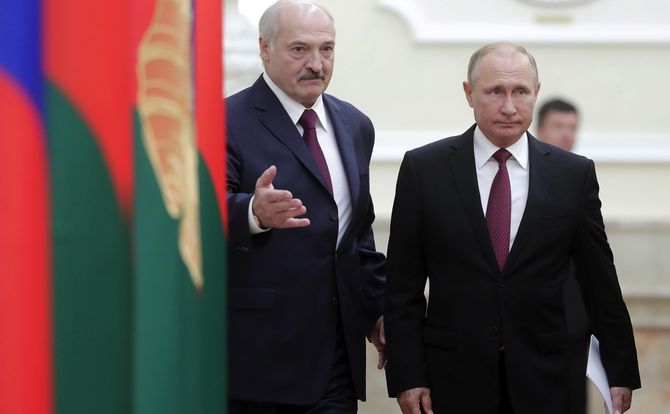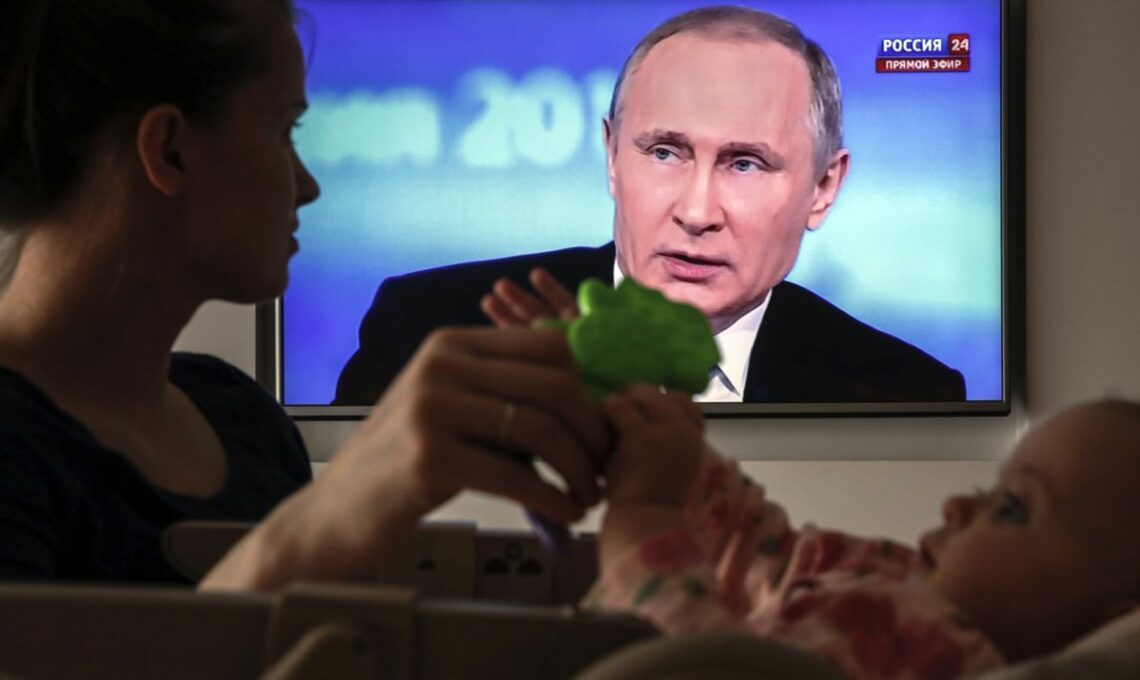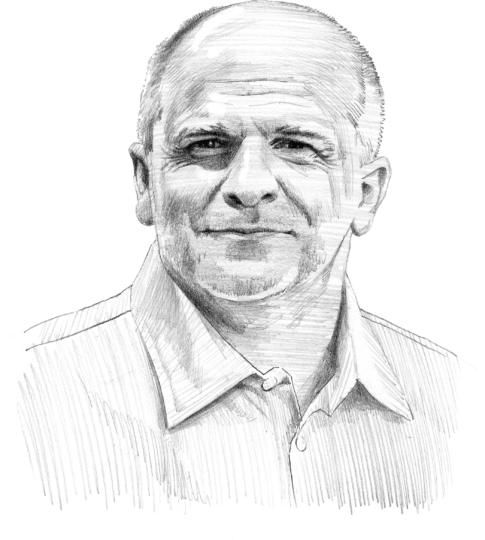What Lukashenko learned from Crimea
Lukashenko is still coming to terms with what intervention of Russia in Ukraine means for his relations with Putin. Events in Armenia show that his overthrow might not occur on the back of Russian tanks but via a “color” revolution. Lukashenko has responded by easing pressure on the opposition, but it may not be enough to save him.

In a nutshell
- Crimea taught Belarus and other post-Soviet states that Russia can redraw their borders
- This spring’s revolution in Armenia showed Russia can replace their leaders
- Belarusian President Lukashenko is taking precautions, but it may be too late
Years ago, President Alexander Lukashenko cherished ambitions of becoming the chief of state of the Union of Russia and Belarus. Today he sees that history is back with a vengeance, and that Minsk is now treated by Moscow as the capital of an insignificant peripheral state on the imperial fringe. The young state farm director who made good as president had dreams that once stretched as far as the Pacific. Now he worries about whether someone in the Kremlin might decide to knock him off his perch and grab his increasingly petty fiefdom.
Mr. Lukashenko is just 64 years old and in good health. Even so, he is a veteran in the post-Soviet political space – only Nursultan Nazarbayev, Kazakhstan’s 78-year-old president, can claim more time in office and a longer institutional memory. But while he has no serious challengers on the domestic political scene, Belarus’s ruler still must worry about staying in power and about what would happen if he loses his grip.
Crimean lesson
The decisive shock for the Belarusian regime came in 2014, with the revolution in Ukraine and the subsequent Russian intervention. Similar reactions to these events could be observed in Kazakhstan and elsewhere.
Put simply, for post-Soviet states that had historically lain in the Russian sphere of influence, Russia’s decision to seize Crimea instantly sorted them into two categories. In the west, Estonia, Latvia and Lithuania were safe because they belonged to NATO and the European Union. Everyone else was served notice that Russia intended to regulate for itself the territorial borders within its former empire. It restored currency to the old joke: “Q: What countries does the Soviet Union border with? A: With any country it likes.”
Of course, the authorities in Minsk know that Russia’s annexation of Crimea and intervention in eastern Ukraine have encountered some opposition and even obstruction in the West. However, they also realize that economic sanctions do not offer any real protection. From the European and U.S. point of view, sanctions inflict pain on Russia. But from the Russian standpoint, they are not nearly painful enough to act as a policy curb.
Crimea blurred the distinction between historically colonial territories and traditional Russian lands.
The new policy toward the European Union adopted by U.S. President Donald Trump has also changed the situation dramatically. This especially applies to the new import tariffs on steel (25 percent) and aluminum (10 percent), which put the sanctions on Russia in an entirely different context. It is no longer clear that the EU can resist the temptation to lift sanctions as a way of providing relief to European firms; it also becomes less likely that the sanctions against Russia will be extended.
Russia’s domestic politics were clearly one of the key motivations for the annexation of Crimea in 2014, since territorial acquisitions served to legitimize President Vladimir Putin’s regime and could be presented to the public as reclaiming what was justly Russia’s. Here the Kremlin introduced some highly useful confusion into the terminology of national sovereignty, blurring the distinction between what were historically “colonial” territories – twice lost, when the Romanov and Soviet empires collapsed – and the traditional Russian lands.
Everyone in the Netherlands knows that Suriname was once part of the Dutch empire, but nobody considers it to be “a part of Holland.” In Russian doctrine, that difference is erased. This is one reason why even in the West one can easily find experts who refer to Russia’s historical right to Crimea.
It also helps explain why President Lukashenko was so alarmed by the seizure of Crimea. If Russia can annex land that it had previously recognized in international treaties as sovereign Ukrainian territory, what was to keep it from repeating the exercise someplace else – say, in Belarus? The sequence of events could be exactly the same. First hybrid warfare, then little green men.
Such fears in Minsk were one reason for Belarus’s reluctance to recognize the Russian-sponsored “republics” of South Ossetia and Abkhazia after the 2008 Russo-Georgian War. This was the first clear violation of an important taboo in the post-Soviet space: that Russia would not tamper with the old borders of the USSR. In Crimea, this taboo was trampled in spectacular fashion.
Armenian lesson
Events in Yerevan, the Armenian capital, in April and May of 2018 also give Mr. Lukashenko food for thought. It was clear that conditions in Armenia had ripened for a popular revolt against the policies of longtime President Serzh Sargsyan (2008-2018). Political conditions in the former Soviet Union leave little room for sentimentality about color revolutions. While they may be based on authentic social unrest and intolerable living conditions, politicians in these countries assume – as a practical matter – that such revolts can only succeed with the backing of either the U.S. or Russia. For this reason, color revolutions in the East are always suspected of being “externally inspired.”
The revolution in Yerevan was a mixture of authentic popular revolt and Russian-supported regime change.
In Armenia, Russia’s strategic interests dictated that it stay in touch with all political circles in the country. Moscow cannot afford to let the country slip from its orbit, especially while it is locked in a “frozen conflict” with Azerbaijan over the disputed region of Nagorno-Karabakh. Moscow would lose important leverage over the authorities in Baku, who would then be free to decide for themselves about security matters. That would amount to a Russian withdrawal from the South Caucasus – a completely implausible scenario.
It is patently obvious that no one can take power in Yerevan without the Kremlin’s seal of approval. The government of Prime Minister Nikol Pashinyan, who led the protests, does not threaten Russian interests in any way. Indeed, the removal of Russian support was probably the decisive factor in Mr. Sargsyan’s ouster. This makes clear that the revolution in Yerevan was a mixture of authentic popular revolt and Russian support for a regime change, quite likely with the quiet acceptance of third countries (such as the U.S.).

It’s worth comparing prerevolutionary Armenia’s internal political situation with Belarus’s for a moment. The Armenian system, especially now, is much more pluralistic and has many of the attributes of a parliamentary democracy, including a functioning opposition. Armenians enjoyed vastly greater freedom of speech than citizens of Belarus, where the political message is tightly controlled. That made it much easier for Armenia’s opposition to mobilize supporters in the capital.
But on the other hand, last spring’s events in Yerevan enlarged on the Crimean lesson that Russia can redraw borders in the former Soviet Union. They showed that the Kremlin can also change national leaders. That Mr. Lukashenko thought long and hard about this was apparent in his comments on April 24, when he criticized the political changes in Armenia. He announced that Belarus would not repeat the mistake made in 2015 by President Sargsyan, who decided to hold a constitutional referendum to change Armenia’s presidential system into a parliamentary republic. Mr. Sargsyan’s aim was to get around presidential term limits (the same “third termism” problem that has plagued many African leaders) and protect his oligarchic proteges, but the move backfired.
Mr. Lukashenko declared his full cooperation with Armenia’s new government at a first meeting with Prime Minister Pashinyan, but these diplomatic niceties should not fool observers. The Belarusian leader is very, very afraid of a Moscow-inspired color revolution in Minsk.
Taking precautions
Mr. Lukashenko’s first reaction to Russia’s newly acquisitive policy was to warm relations with the EU. This is not the first time he has shown pro-Western sympathies in his political career. However, the strategic importance of this demarche is greater and it has lasted longer. In a characteristic touch, the regime’s more moderate representatives, such as Foreign Minister Vladimir Makei, have been nudged to the fore. The signal is strengthened because Mr. Makei (along with top officials of Belarus’s central bank) is considered among the leading candidates to succeed President Lukashenko should he leave office for any reason.
At the same time, Minsk needed to seek Russian financial assistance – but without cutting its ties with the West. An intermediary was found to make Belarus’s case to the EU – Poland, whose government wanted a fresh approach to eastern policy after taking office in 2015. Both sides benefited. For Minsk, the cooperation was worth its weight in gold, since Warsaw had long been a leading critic of the Lukashenko regime. The new opening brought few political changes in Belarus, but at least cleared the atmosphere. It did, however, produce a significant cooling of relations with Lithuania, which strenuously objected to the construction of a 2,400-megawatt nuclear plant at Ostrovets, just 40 kilometers from its capital, Vilnius. The other big loser from the EU’s softer line toward Minsk was the Belarusian opposition, whose political importance dwindled.
Mr. Lukashenko’s fellow citizens live in Belarus, but their mental maps remain inside Russia.
Perhaps Mr. Lukashenko’s biggest problem is that while his fellow citizens live within the borders of Belarus, their mental maps remain very much inside Russia. The two countries are almost totally integrated in terms of the news and information media. The real nightmare for the authorities in Minsk – and the spur to some real policy changes – has been the power of Russia’s propaganda machine. President Lukashenko may have changed course after the annexation of Crimea, but Belarusians’ views are molded entirely by the Russian media, which keep harping on Moscow’s rightful claim to the peninsula and the inevitability of armed intervention.
The whole situation is payback for Mr. Lukashenko’s long-term policy of discouraging the Belarusian language and reducing national culture to folklore and paper cutouts. To repair the damage, the government has reversed course with a minor “Belarusification” policy, or what some people have called “controlled patriotism.” Even media outlets that the regime once treated as enemies – such as Belsat, a Polish-based television station that broadcasts to Belarus on the surrogate model of Radio Free Europe – are now seen as fitting within the new line of defending the national heritage. In March 2018, the 100th anniversary of the Belarusian People’s Republic and its declaration of independence were officially marked by the authorities in Minsk. The idea was to show Belarusians that they are not some local variant of Russians, but a people with their own national identity.
Lukashenko’s options
On June 19, practically the entire political leadership of Russia (including President Putin and Prime Minister Dmitry Medvedev) visited Minsk for a meeting of the Russia-Belarus Supreme State Council. In this theoretical union of two countries, the personal relationship between Mr. Putin and Mr. Lukashenko is crucial. Yet the two men cannot regain their former level of trust. It appears Russia has not yet made a leadership change in Belarus only because it has more urgent matters to deal with.
Nevertheless, Mr. Lukashenko rules at the Kremlin’s whim. The latest demonstration of this fact are restrictions on the sale of Belarusian dairy and meat products in Russia, where they had enjoyed great popularity. Mr. Lukashenko responded by blocking further steps in the political integration of the two countries – for example, the creation of shared consulates or a joint command for air defense. In his public statements, the Belarusian president is careful to avoid criticizing his eastern neighbor, yet keeps dropping hints that life in his country is easier and safer. These nuances are not missed by observers in the Kremlin. At best, Belarus’s official media now depict Russia in neutral tones.
The regime may adopt some variant of the Chinese model, liberalizing selected industries and selling a few assets.
Mr. Lukashenko’s own public statements betray increasing pessimism. On June 22, during a meeting with senior officials, he questioned whether annexation by Russia could be avoided. “If we don’t make it through the next few years, if we fail, it will be necessary to merge with another country. Otherwise, we’ll become a doormat. Or – God forbid – they’ll start a war here the way they did in Ukraine.”
This political balancing act will not end anytime soon. In the ideological sphere, Mr. Lukashenko will continue to introduce elements of Belarusian patriotism and a broader toleration for the Belarusian language. In the political realm, there will be more lenient treatment of the opposition and probably no return to the policy of savage repression. Economically, the regime will likely adopt some variant of the Chinese model. This could mean liberalization of selected industries and the sale of a few state-owned enterprises, but under strict government control and without introducing wider civic freedoms.
Only in this way can Mr. Lukashenko preserve at least the illusion of security. He will hope to secure new budget revenue and savings; most of all, through a policy of small steps, he will try to creep away from Russian tutelage.








